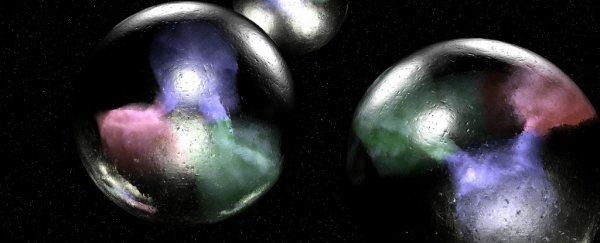Physicists working with the Large Hadron Collider beauty experiment (LHCb) have discovered what appears to be an entire family of new particles that our current physics models can't explain.
The existence of these new forms of matter, known as tetraquarks, challenges our current understanding of the role they play inside the protons and neutrons that make up atoms - the fundamental building blocks of everything we know and love in the Universe.
"We looked at every known particle and process to make sure these four structures couldn't be explained by any pre-existing physics," one of the team, Thomas Britton from Syracuse University, told Sarah Charley at Symmetry. "It was like baking a six-dimensional cake with 98 ingredients and no recipe - just a picture of a cake."
So first off, what's a tetraquark? In their simplest form, quarks are minuscule particles that accumulate inside the protons and neutrons inside atoms, smashing about and annihilating each other at near-light speed.
As this video by Physics Girl explains, according to the current standard model of physics, quarks can come in six different types, or 'flavours': up, down, top, bottom, strange and charm. They're all held together by even smaller particles called gluons, and depending on their mass, are classified as heavy or light.
Until recently, it was thought that quarks only come in groups of two or three, but in 2014, physicists at the LHCb - one of seven particle physics detector experiments at the Large Hadron Collider accelerator at CERN in Switzerland - confirmed the existence of a four-quark particle called a tetraquark.
Then last year, they one-upped this discovery by confirming the existence of another type of quark - a five-quark particle, or pentaquark.
None of this was easy, as experienced by a separate team of researchers from the Fermilab particle physics facility near Chicago, who announced that they too had discovered a new tetraquark earlier this year, only to be met with a whole lot of scepticism.
But now the Syracuse team at the LHCb - which offers far more detection sensitivity than the Fermilab particle accelerator - has identified four new types of tetraquarks that appear to belong to the same exotic family.
"What we have discovered is a unique system," says one of the team, Tomasz Skwarnicki. "We have four exotic particles of the same type; it's the first time we have seen this and this discovery is already helping us distinguish between the theoretical models."
The new particles have been named X(4140), X(4274), X(4500), and X(4700) after their respective masses, and each one has been found to contain a unique combination of two charm quarks and two strange quarks. This makes them the first four-quark particles found to be composed entirely of heavy quarks, Symmetry reports.
By 'exciting' the individual quarks inside their new tetraquark particles, the researchers were able to observe their unique internal structure, mass, and quantum numbers. In doing so, they discovered something that doesn't fit with current physics models that work with so-called ordinary particles, such as composite hadrons built from either a quark and an anti-quark, or three separate quarks, CERN reports.
Physics are now trying to come up with new models to explain their results.
The results have been published in two papers on the pre-print website arXiv.org here and here, so are now going to be scrutinised by independent physicists ahead of the formal peer-review process.
The team is expecting one of two possibilities to be confirmed with further research: theoretical psycists are either going to have to explain the existence of this new family of particles, or they could be idenfified as the result of strange 'ripple effects' emanating from never-before-seen behaviours of existing particles.
"The molecular explanation does not fit with the data," Skwarnicki told Charley at Symmetry.
"But I personally would not conclude that these are definitely tightly bound states of four quarks. It could be possible that these are not even particles. The result could show the complex interplays of known particle pairs flippantly changing their identities."
